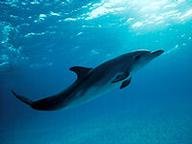Quiz Answer Key and Fun Facts
1. Before setting out for the day, Bello the bottlenose dolphin wants to make one thing clear - he is not a fish. Bello is actually part of the suborder Odontoceti, or toothed whales. Which of these other marine mammals is *not* a fellow member of this suborder?
2. Despite Bello the bottlenose dolphin's earliest mammalian ancestors being small, tree-dwelling insectivores, he has become so perfectly adapted to life in the water that you are hard-pressed to keep up with him. Which of these evolutionary adaptations is *not* a way in which a dolphin has become more streamlined?
3. The first major feeding for Bello the bottlenose dolphin will take place in the morning, when he and several other dolphins move out to deeper waters to find fish. Though Bello does not often need to dive to great depths, he is very capable of doing so. How does Bello's heart allow him to dive to great depths?
4. As Bello and the other bottlenose dolphins drive a large shoal of fish to the surface of the water, they work in perfect synchronicity to pack the fish closer together and to make sure that each dolphin gets enough food. Which other animals most often benefit from this hunting technique?
5. Once fed, Bello will meet with several other dolphins. Dolphins are known for their unique vocal ability, which is the most vital tool for social interactions between these marine mammals. This range of sounds is produced by the vibration of a pair of lips located just beneath the blow hole. What odd name is given to these lips?
6. The detection of reflected sound waves is aided by the characteristic bulbous shape of Bello the bottlenose dolphin's head. What name is given to this domed area?
7. One of the female dolphins Bello the bottlenose introduces you to is heavily pregnant. Knowing that dolphins are mammals, and so obtain their oxygen from air as opposed to water, you know that a dolphin's birth can be a bit tricky. Which of these is the usual way that baby dolphins are born?
8. After spending time with Bello the bottlenose dolphin, you begin to notice some rather uncharacteristic aggressive behaviour. Which animal has been the victim of several filmed dolphin attacks, giving a stark contrast to the usual gentleness associated with dolphins?
9. The grace, intelligence, and anthropomorphic qualities of dolphins such as Bello have led to several measures being introduced to protect their population in the wild. Which unusual occurrence, such as that on the Pieman River, Tasmania, in 2010, has caused much concern for conservationists?
10. After a long day with Bello the bottlenose dolphin, you recognise that he must be tired and so needs a sleep. Whilst whales and dolphins will usually only enter a half sleep, so as to keep a look out for predators, they do sometimes enter deeper sleeps. What are these deep sleeps often called?
Source: Author
doublemm
This quiz was reviewed by FunTrivia editor
crisw before going online.
Any errors found in FunTrivia content are routinely corrected through our feedback system.
